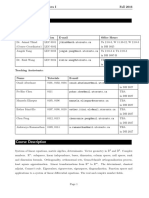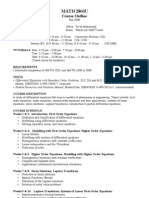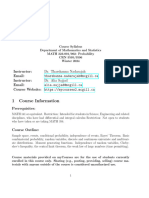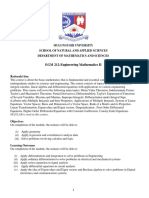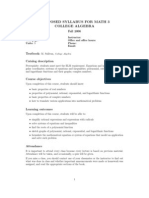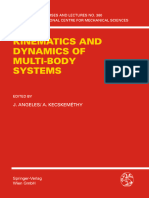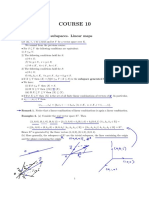Unmate if have There will be lictures/office hours this
yourself ! no on
at
any
time
you any questions
- Widursday and next work
MAT223: Linear Algebra I
↓
Lecture Hours: Monday 10h00-11h00 and Wednesday 9h00-11h00 (online)
-
for Drop assignments midturn
Instructor: Sabrina Lin Only course
logistics : more .
OH
appointment
-
,
~ Math Quations : Plazza , OH
Email: srn.lin@mail.utoronto.ca
O!ce Hours: Monday 9h00-10h00 or by appointments (online)
-
Course Description: A first course on linear algebra in R𝐿 emphasizing the interplay between algebraic
and geometric perspectives. Topics include systems of equations, Gaussian elimination, representations of
lines and planes, dot products, subspaces and translated subspaces, bases and change of basis, projections,
the rank and nullity of a linear transformation, the rank/nullity/row space/column space of a matrix, matrix
inverses, determinants, eigenvectors and eigenvalues, and matrix diagonalization. While not emphasizing
proofs, this course does maintain a careful distinction between vectors and their representation in a basis
as well as between matrices and linear transformations. You sucted to be Emilia with arc
2x)
all the difs and thus
Prerequisites: High school level calculus
Recommended Textbooks:
1. Introduction to Linear Algebra by Gilbert Strange
3
You don't mum to
buy thre !!!
2. Linear Algebra Done Right by Sheldon Axler
-
How this course is organized:
This course will consist of two weekly lectures and a weekly tutorial. Zoom will be used for all lec-
tures, tutorials, and o!ce hours. Tutorials will start on the week of May 12th. The attendance of the
tutorials is not mandatory but encouraged. During the tutorials, TAs will discuss the weekly practice
problems. Course announcements will be made on Quercus. Computational-based assignments will
be assigned through WeBWork (you can access them by clicking “Launch External Tool” if you go to
“Quercus-Modules-Week x-Computational-based assignment x”), and proof-based assignments should
be submitted through Gradescope. The midterm will be assigned and should be submitted through Grade-
scope. The final exam will be in person. Plazza For discussion
Technical Requirement:
For the online, time-restricted midterm, students are required to have reliable internet access. If you are
facing financial hardship, you are encouraged to contact college or divisional registrar to apply for an
emergency bursary.
Evaluation:
1. Computational-based assignments (15%)
2. Proof-based assignments (15%)
3. Midterm Assessment (30%)
4. Final Assessment (40%)
1
�Computational-Based Assignments:
There will be a computational-based assignment every week. You are allowed to have infinite attempts
during the time frame.
Proof-Based Assignments:
There will be a proof-based assignment every week. The lowest grade will be dropped. For these
problem sets, you may discuss the problems with other students in the class, but you must write up
your solution in your own words. If you consult any additional resources (recommended textbooks,
websites) you should acknowledge them.
Midterm Assessment:
There will be an online, 2-hour midterm. It will take place during the regular class time on June 11.
Final Assessment:
The final assessment will be held in person during the final assessment period and will be scheduled by
the registrar. Information about the format will be provided during the Summer semester.
Policy on Missed Term Works:
Late assignments will not be accepted. At the discretion of the instructor, additional drops of the assign-
ments may be accepted.
Students who are absent from class for prolonged periods and who require consideration for missed
academic work should contact the instructor and verify their absence(s) through either the Absence Dec-
laration tool, Verification of Illness or Injury (VOI) form, College Registrar Letter, or Letter of Academic
Accommodation from Accessibility Services, as appropriate to their situation.
The absence declaration can be used once per term. Outside of the one time absence declaration use,
students must adhere to the alternate processes for absences listed above, as well as the missed work
policy as set out in each course’s syllabus.
If you miss a term test, you must inform your course Instructor within 72 hours of the test. No exceptions.
If your request is approved, you may receive an accommodation. The accommodation to be used will
be decided by your instructor. Some examples of accommodations may include: an oral exam, written
make-up test, or a re-weighting of your assessments.
Re-marking Policy: don't waid
-
A student who believes an individual item of work has been incorrectly or unfairly marked may ask the
person who marked it for a re-evaluation by submitting a regrade request through Gradescope. With
evidence to back their appeal, students should make such requests as soon as reasonably possible after
receiving the work back, but no later than 2 weeks after it was returned.
Email Policy:
Should you have a question that is not answered on the course site (please check there first!) please note
that all communications with the Course Instructor or TA’s must be sent from your o!cial utoronto email
address, with the course number included in the subject line. If these instructions are not followed,
your email may not be responded to. Please write in a professional manner.
2
�Plagiarism Detection Tool:
A plagiarism detection tool may be used for detecting plagiarism in some of the written work submitted in
this course. Normally, students will be required to submit their written work to the university’s plagiarism
detection tool for a review of textual similarity and detection of possible plagiarism. In doing so, students
will allow their work to be included as source documents in the tool’s reference database, where they
will be used solely for the purpose of detecting plagiarism. The terms that apply to the University’s
use of the this tool’s service are described on the Centre for Teaching Support and Innovation web site:
https://teaching.utoronto.ca/resources/plagiarism-detection/
Academic Integrity:
All suspected cases of academic dishonesty will be investigated following procedures outlined in the
Code of Behaviour on Academic Matters. If you have questions or concerns about what constitutes
appropriate academic behaviour or appropriate research and citation methods, please reach out to your
Course Instructor. Note that you are expected to seek out additional information on academic integrity
from me or from other institutional resources.
Accessibility:
The University provides academic accommodations for students with disabilities in accordance with the
terms of the Ontario Human Rights Code. This occurs through a collaborative process that acknowledges
a collective obligation to develop an accessible learning environment that both meets the needs of students
and preserves the essential academic requirements of the University’s courses and programs.
Students with diverse learning styles and needs are welcome in this course. If you have a disability that
may require accommodations, please feel free to approach your Course Instructor and/or the Accessibility
Services o!ce as soon as possible. The sooner you let us know your needs the quicker we can assist you
in achieving your learning goals in this course.
3
�Wick 1
System of lineys
:
Problem We want to build castle different of LEGO
using types
:
a
of LEG I hav
Towns Stables Horses #
a
Als Alt
Type 2 ALT Als ALH
B not as by
0 : How tows/stables/ horse should I build if Iwant to
many
hou the exact amount of LEGO I har ?
up
& Towers
Assum
It is the # of Stables
Horses
I should build
Amount of LEGO used Amount of LEGO I him
X system of
eys
= bi
I
-
il
/
2
T-S AH linear
=
+
DASHH
I
J
-
IHS variables ·
criffs #
� n= 3 X ,
Y , z
Dif (New
zy) A linem
eg
in variable X ...... Xn is an
egnation
which take the form Q=
where as az , ...,
an,b are Bul numbers .
-
not
depending on ....... Xu
X
Ex :
Dutomine in / not lin
1 x + z 5 X
y
=
+
.
(x' z 2v
zy
3 .
+ + =
T(x
3 +
y)
z =
Ex 2yz 0
=
+ =
.
4
.y X e 1 X
=
3 =
Dif I of 12
System zg)
A collections of the
system
of
lineys is a
linegs in Saman variables .
A Su)ER" solution of lin
taple /S .. .... is r to the
system eg"
if Is , , Sul sol all in the
system
is to
..., a
egs .
Ex
I
:
is of lin
system
a
-
zg
↑
� sol of
106) ,
is a this
system
700 1 (3) + 5 6 27
[
+ .
.
=
4.0 +
3 ( 3) 5 16) 2)
.
-
+
. =
6 .
0 + 1 .
(3) + 2 .
6 =
9
X Z
Y
I I IB
[ " E
-
Ax 1y = 2 + + 2
LHS RAS
Matrix of of
representation a
system liney
Daf/nxm matrix and its entries (
A of
matrix is a
rectangular array quantitie or
expressions
(i e
. .
Ral #) The the
or
complex .
quantities
or
expressions in matrix is
called its "intries" . If a matrix has n rows and m columns ,
RC
we call it a nxm
>
-
matrix
.
## of rows(* /# of columns) 4x3 Matrix
Example
:
2x3 matrix
I in))uR
I 4
(135
l 13415
se
�Dif (Matrix of confficients and of
augmented matrix
system
a of
liney)
Given a of lin :
system egs
anxt
bi
Ky be
I
-
X, +
H2Xz +... +
Ai Xn =
,
-
-
X + 122x + ...
br
edific
manuxu +... + amexm =
In
I
its
# RHS
LHS
Ex
= bi
ATT
-
USS
+ AcHH
+ azsS +
+
#H -
=
a) b
�liff matrix
Augmental matrix
I an ) (
UIT








